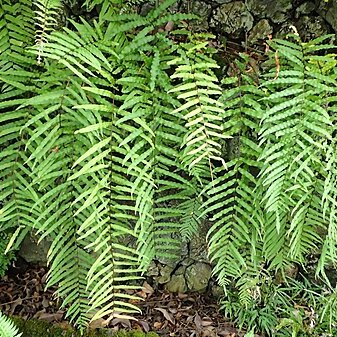Rhizome 6-8 mm in diam., glaucous underneath scales, densely scaly at least at apex; scales dark brown, narrowly lanceolate, ca. 5 × 0.7 mm, margin toothed. Stipe straw-colored or brown, 25-35 cm, base densely scaly, distally minutely scaly or glabrescent; rachis pale brown, minutely scaly throughout; lamina lanceolate in outline, 80-100 × 30-40 cm; lateral pinnae 30-40 pairs, sessile, linear, basal pinnae usually slightly shorter than next above, deflexed or spreading; middle pinnae subopposite, spreading or slightly ascending, straight or slightly falcate, 14-20 × ca. 2 cm, base subcordate or truncate, rounded auriculate on both sides, gradually narrowing from base to long attenuate apex, margin serrate, upper pinnae progressively smaller; terminal pinna 5-10 cm, basal portion irregularly lobed; lamina herbaceous or thinly leathery, green, glabrous or pubescent when young. Sori orbicular, at tip of simple included veinlets in costal areoles, in 1 row on each side of costa, distinctly sunken on abaxial surface and raised on adaxial surface.
Rhizome chalky white. Scales ±deciduous, reddish brown, 2-6 mm long, 0.5-1.6 mm wide; base broad, rounded, tapering to a long narrow hair-like apex; margins with short fine rigid teeth. Fronds 10-120 cm long. Stipe 5-63 cm long, scaly at base; scales as for rhizome but usually longer, narrower. Lamina 1-pinnate, becoming pendulous. Pinnae very narrowly ovate to linear, c. 1-2.5 cm apart, articulated to rachis, 0.3-25 cm long, 0.25-2 cm wide, sessile; base truncate, cordate or very broadly cuneate, often slightly lobed on 1 or both sides, tapering to an acute apex; margins shallowly and bluntly dentate, thin, firm, clothed with soft pale hairs when young, glabrescent apart from small scattered scales on main rachis and on lower surface of costae. Veins usually forming 2 series of areoles between costa and margin; outer series mostly without free included veinlets. Sori solitary in each of the innermost areoles, not ringed by dark scale-like paraphyses; sporangia immersed in shallow depressions. Spores 32.5-52.5 µm long, 17.5-25 µm wide.

